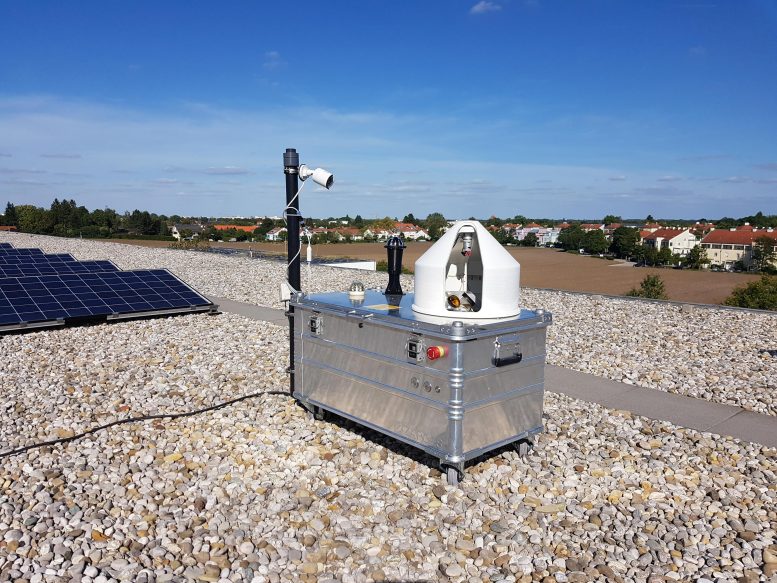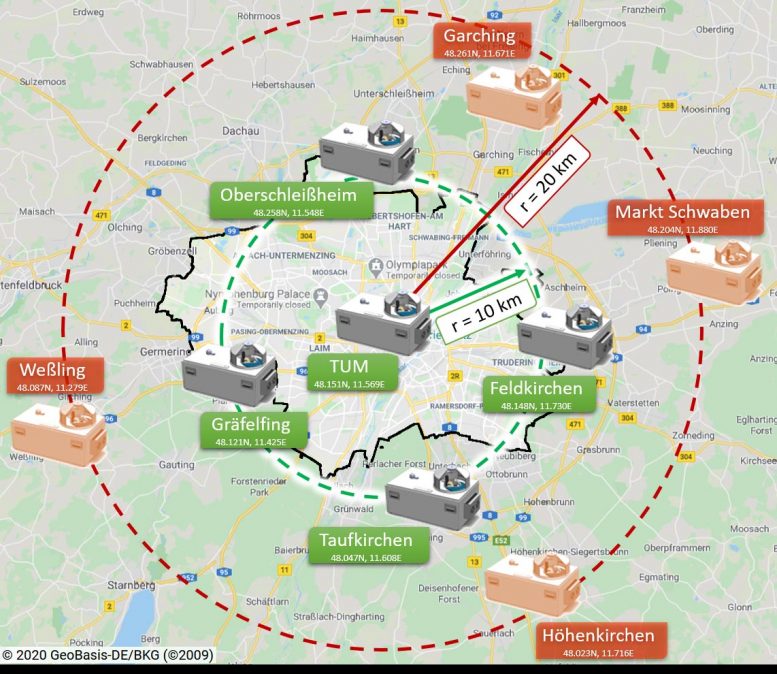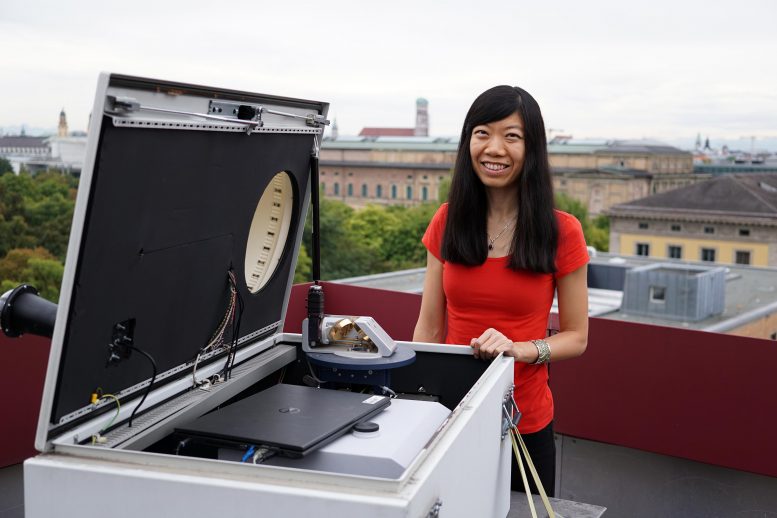
Measuring device of the MUCCnet sensor network set up by Prof. Jia Chen, Chair of Environmental Sensing and Modeling, at the TUM Department of Electrical and Computer Engineering of the Technical University of Munich (TUM) on the roof of a building in Taufkirchen. Credit: F. Dietrich / TUM
MUCCnet: Precision technology allows quantification of urban greenhouse gas emissions.
Munich is home to the world’s first fully automated sensor network for measuring urban greenhouse gas emissions based on ground-based remote sensing of the atmosphere. It has been developed by scientists in the group of Jia Chen, Professor of Environmental Sensing and Modeling at the Technical University of Munich (TUM). Now, anyone can view the measurement data via an Internet platform.
The sensor network MUCCnet (Munich Urban Carbon Column network) consists of five high-precision optical instruments that analyze the sun’s light spectra. They measure the concentration of the gases carbon dioxide (CO2), methane (CH4) and carbon monoxide (CO). Since each gas has its own unique spectral “fingerprint”, concentrations of these gases can be determined in the columns of air between the instruments and the sun. “By measuring a vertical column of the atmosphere, local disturbances, such as the disproportionate influence of neighboring stacks, can be removed. Therefore, this type of greenhouse gas balancing is considered particularly robust and accurate,” says Prof. Jia Chen.
Measurements at five locations in and around Munich
One of MUCCnet’s measurement devices is located on the main campus of TUM and measures inner-city concentrations. Four other devices are located at the Munich city borders in all four cardinal directions (north: Oberschleissheim, east: Feldkirchen, south: Taufkirchen and west: Graefelfing).

Overview map of the locations of the measuring devices of the MUCCnet sensor network set up by Prof. Jia Chen, Chair of Environmental Sensing and Modeling, at the TUM Department of Electrical and Computer Engineering of the Technical University of Munich (TUM). Credit: TUM
Chen explains the principle in simple terms: “We set up one sensor upwind from the city and the second downwind. So any increase in gases between the first sensor and the second must have been generated from inside the city.” To cover as many wind directions as possible, there is a sensor in each cardinal direction. With the input of the sensor data and meteorological parameters, high-performance computers can create a spatially resolved emission map of the city.
Using measured data to improve the calculated emission figures
Under the Paris Climate Agreement, atmospheric measurements are not required to meet emissions targets. “Instead, the emissions numbers we hear in the news are based on calculations,” explains Prof. Chen.
Among other things, this makes it impossible to detect so far unknown sources — such as leaks in gas pipelines. Therefore, Prof. Jia Chen’s team and project leader Florian Dietrich created MUCCnet to measure emissions with high precision, which can reduce inaccuracies in calculations.
Corona lockdown as a natural experiment for the measurement data series
The current Corona crisis provides a useful natural experiment for researchers because as a result of the two German lockdowns in spring 2020 as well as winter 2020/21 and severe air traffic curtailment, there have been changes in urban greenhouse gas emissions, which can be used to validate measurements as well as atmospheric transport models.

Prof. Jia Chen, Chair of Environmental Sensing and Modeling at the TUM Department of Electrical and Computer Engineering of the Technical University of Munich (TUM) at a measuring device of the MUCCnet sensor network on the roof of a building at the main campus of the TUM in Munich. Credit: TUM
Unfortunately, the lifetime of CO2 is very long (several hundred years) and measurement results show that even such a drastic global event as this pandemic has not stopped the annual increase of CO2 concentration in the atmosphere.
Measurement data can be accessed online
Since the start of 2021, the researchers have operated a website which not only makes measurement data available to everyone, but also explains the devices used and the principles employed to gain the data. Interested parties can find absolute values of greenhouse gas concentrations on the portal and can, for example, draw comparisons between stations at different locations.
“Since climate change is a global problem, the Munich network should only be the first step,” says Prof. Chen. In the future, Chen’s team plans to use measurements from existing greenhouse gas satellites to expand the methods and models developed in Munich worldwide and thus make a decisive contribution to understanding and solving the climate problem.
Reference: “MUCCnet: Munich Urban Carbon Column network” by Florian Dietrich, Jia Chen, Benno Voggenreiter, Patrick Aigner, Nico Nachtigall and Björn Reger, 11 February 2021, Atmospheric Measurement Techniques.DOI: 10.5194/amt-14-1111-2021